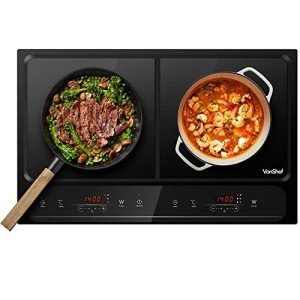A Complete Guide To Induction Hob Buying Guide Dos And Don'ts
Induction Hob Installation: A Comprehensive Guide
Induction hobs have actually gotten popularity in modern kitchen areas due to their energy efficiency, speed, and precision in cooking. Unlike conventional gas or electric cooktops, induction hobs use electro-magnetic energy to straight heat up pots and pans. This innovative innovation not just improves cooking efficiency but likewise improves safety by lessening the danger of burns. However, installing an induction hob needs cautious preparation and consideration of numerous aspects. This short article offers a step-by-step guide to induction hob installation, in addition to essential tips, benefits, and regularly asked questions.
Benefits of Induction Hobs
Before delving into the installation procedure, let's explore some benefits of induction hobs that make them a preferred option for numerous families:
- Energy Efficiency: Induction hobs use less energy as they move heat directly to pots and pans, causing faster cooking times and decreased energy expenses.
- Security: The surface of an induction hob does not fume during cooking, substantially lowering the threat of burns or fire risks.
- Easy Cleaning: The flat surface of induction hobs makes them easy to tidy, as spilled food does not get baked onto the surface area.
- Exact Control: Induction hobs ensure rapid temperature modifications, enabling precise control over cooking temperature levels.
Secret Considerations Before Installation
1. Electrical Requirements
Induction hobs need a greater electrical output compared to standard electric hobs. Ensure that Induction Hob Retailer satisfies the requirements of your particular induction design, normally 3 kW to 7.4 kW.
2. Cookware Compatibility
Induction cooking depends on magnetic cookware. Simplistically, if a magnet adheres to the bottom of your pots and pans, they appropriate for induction cooking.
3. Worktop Specifications
Your kitchen area worktop must support the weight of the induction hob and accommodate the installation measurements. Make sure that the worktop material is heat-resistant and appropriate for kitchen area use.
4. Space Utilization
Think about the readily available area in your cooking area and how the induction hob will fit within that environment. You ought to likewise leave sufficient clearance for air flow around the device.
Table 1: Induction Hob Dimensions and Space Requirements
Induction Hob Size
Minimum Installation Depth
Minimum Clearance Height
Suggested Countertop Thickness
30 cm
60 cm
30 cm
2.5 cm to 4 cm
60 cm
60 cm
30 cm
2.5 cm to 4 cm
90 cm
60 cm
30 cm
2.5 cm to 4 cm
Step-by-Step Guide to Installing an Induction Hob
This section offers a detailed installation process, making sure that your induction hob is established safely and properly.
Step 1: Gather Required Tools and Materials
- Induction hob
- Screwdriver
- Level
- Determining tape
- Underlay or insulation products
- Electrical circuitry (speak with an expert electrical contractor)
Step 2: Prepare the Worktop
- Measure the Installation Area: Ensure that the worktop has sufficient area for the hob. Utilize a measuring tape, and mark the details of the needed cut.
- Cut the Opening: Using a proper saw, cut the opening in the worktop, guaranteeing smooth edges.
- Clean the Area: Remove any debris or dust from the cut area to prepare for installation.
Action 3: Position the Hob
- Place the Hob: Carefully position the hob in the ready opening, ensuring it is level.
- Secure with Clips: If your design features installation clips, utilize them to secure the hob to the worktop.
Step 4: Electrical Connection
- Connect to Power Supply: This action should be performed by a certified electrical contractor. Follow the manufacturer's instructions for wiring, ensuring that all connections are secure and adhere to local electrical guidelines.
Step 5: Check for Leaks
- After linking the induction hob, turn it on to check its performance. Make sure there are no spaces in between the hob and worktop that could cause water ingress.
Step 6: Finalize the Installation
- When checked, make sure that all screws are tightened, and the hob is flush with the worktop. Clean the surface area to remove any finger prints or particles.
Frequently Asked Questions about Induction Hob Installation
1. Is it safe to install an induction hob myself?
While DIY installation is possible for those with electrical understanding, it's advisable to hire an expert electrician to make sure security and compliance with regional regulations.
2. What are the typical problems during installation?
Typical problems consist of incorrect measurements, failure to examine cookware compatibility, and inadequate electrical supply.
3. Can I set up an induction hob over a drawer or cabinet?
It is not suggested to install an induction hob directly over a drawer without suitable heat insulations, as it may trigger damage to the cabinetry.
4. How do I know if my pots and pans works?
Conduct an easy magnet test. If the magnet adheres to the bottom, your cookware is induction compatible.
5. What should I do if the hob does not warm up?
Inspect the power supply and confirm that the hob is properly set up. If problems continue, consult the manufacturer's support or a certified technician.
Induction hobs offer a modern and effective cooking option that can boost any kitchen area. While installation may seem complicated, comprehending the requirements and following an extensive guide can streamline the process. Prospective buyers need to consider employing an expert for electrical connections to make sure security. With the right preparation and knowledge, installing an induction hob can change cooking experiences in remarkable methods.
With this details at hand, prospective users can make informed decisions about transitioning to induction cooking and installing their new hobs, causing a safer and more efficient kitchen.
